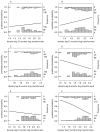Contrasting dynamics of Bartonella spp. in cyclic field vole populations: the impact of vector and host dynamics
- PMID: 17096870
- PMCID: PMC2952920
- DOI: 10.1017/S0031182006001624
Contrasting dynamics of Bartonella spp. in cyclic field vole populations: the impact of vector and host dynamics
Abstract
Many zoonotic disease agents are transmitted between hosts by arthropod vectors, including fleas, but few empirical studies of host-vector-microparasite dynamics have investigated the relative importance of hosts and vectors. This study investigates the dynamics of 4 closely related Bartonella species and their flea vectors in cyclic populations of field voles (Microtus agrestis) over 3 years. The probability of flea infestation was positively related to field vole density 12 months previously in autumn, but negatively related to more recent host densities, suggesting a dilution effect. The 4 Bartonella species exhibited contrasting dynamics. Only B. grahamii, showed a distinct seasonal pattern. Infection probability increased with field vole density for B. doshiae, B. taylorii and BGA (a previously unidentified species) and with density of coexisting wood mice for B. doshiae and B. grahamii. However, only the infection probability of BGA in spring was related to flea prevalence. B. doshiae and BGA were most common in older animals, but the other 2 were most common in non-reproductive hosts. Generally, host density rather than vector abundance appears most important for the dynamics of flea-transmitted Bartonella spp., possibly reflecting the importance of flea exchange between hosts. However, even closely related species showed quite different dynamics, emphasising that other factors such as population age structure can impact on zoonotic risk.
Figures




References
-
- Albright JW, Albright JF. Rodent trypanosomes – their conflict with the immune-system of the host. Parasitology Today. 1991;7:137–140. - PubMed
-
- Begon M. Effects of host diversity on disease dynamics. In: Ostfeld RS, Keesing F, Eviner V, editors. Ecology of Infectious Diseases: Effects of Ecosystems on Disease and of Disease on Ecosystems. Princeton University Press; 2007. in the Press.
Publication types
MeSH terms
Grants and funding
LinkOut - more resources
Full Text Sources
Miscellaneous

